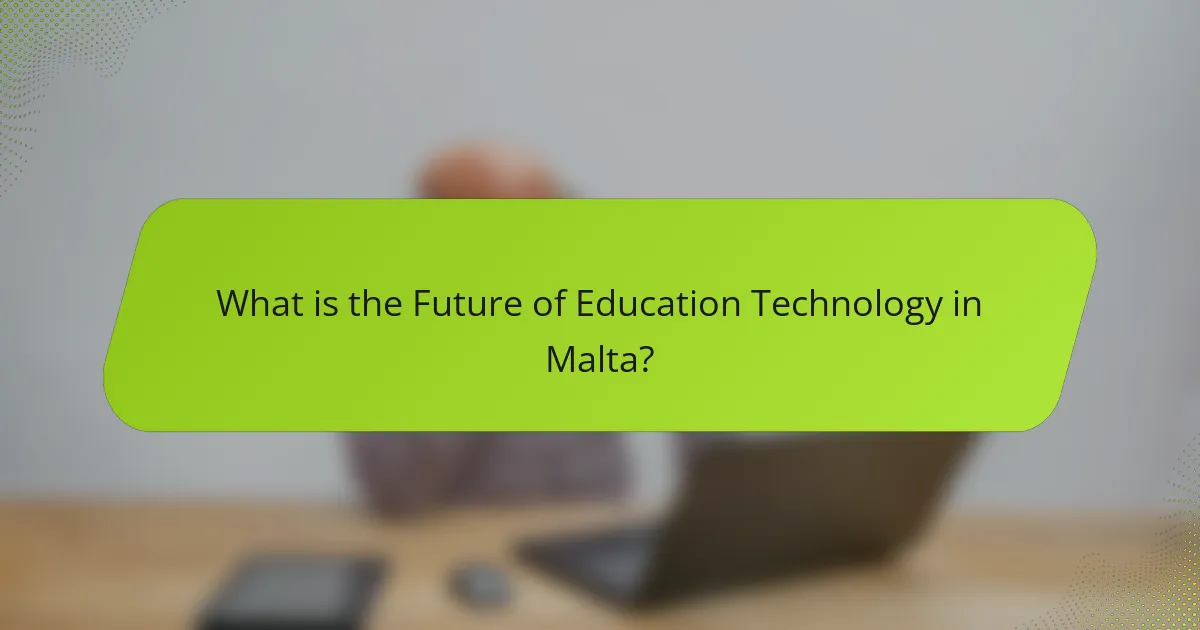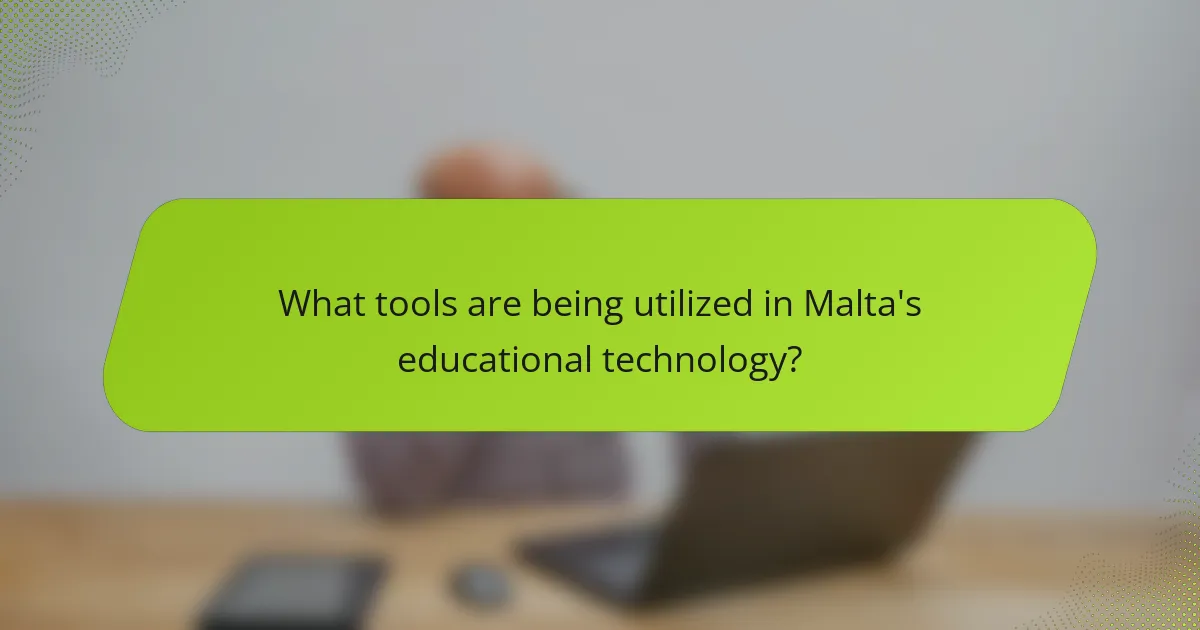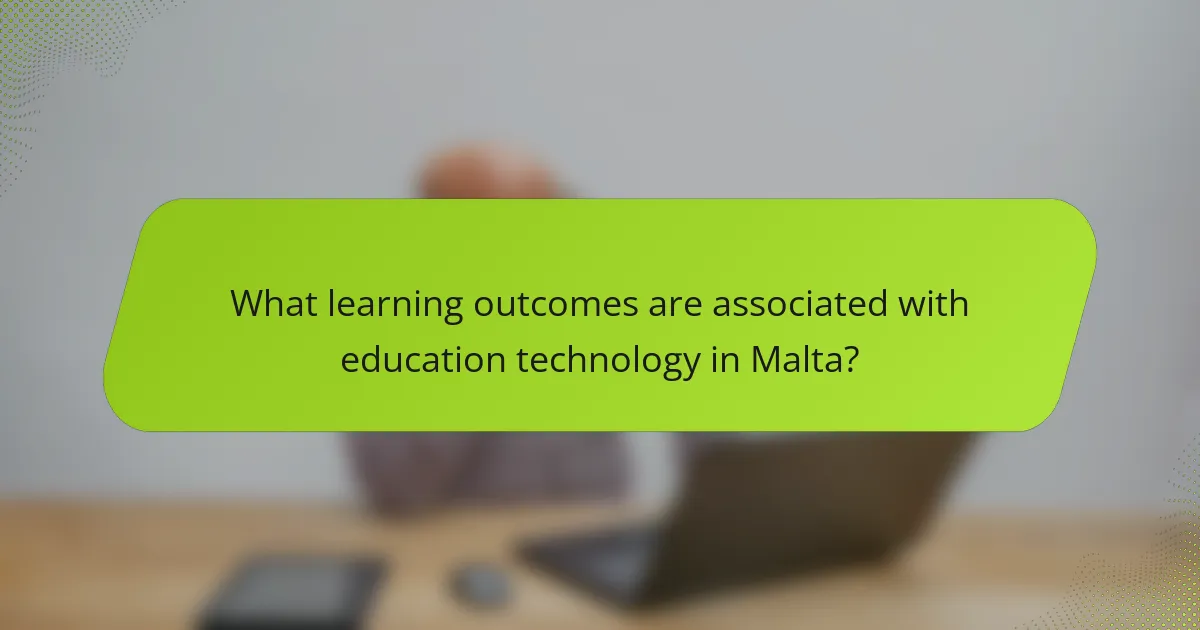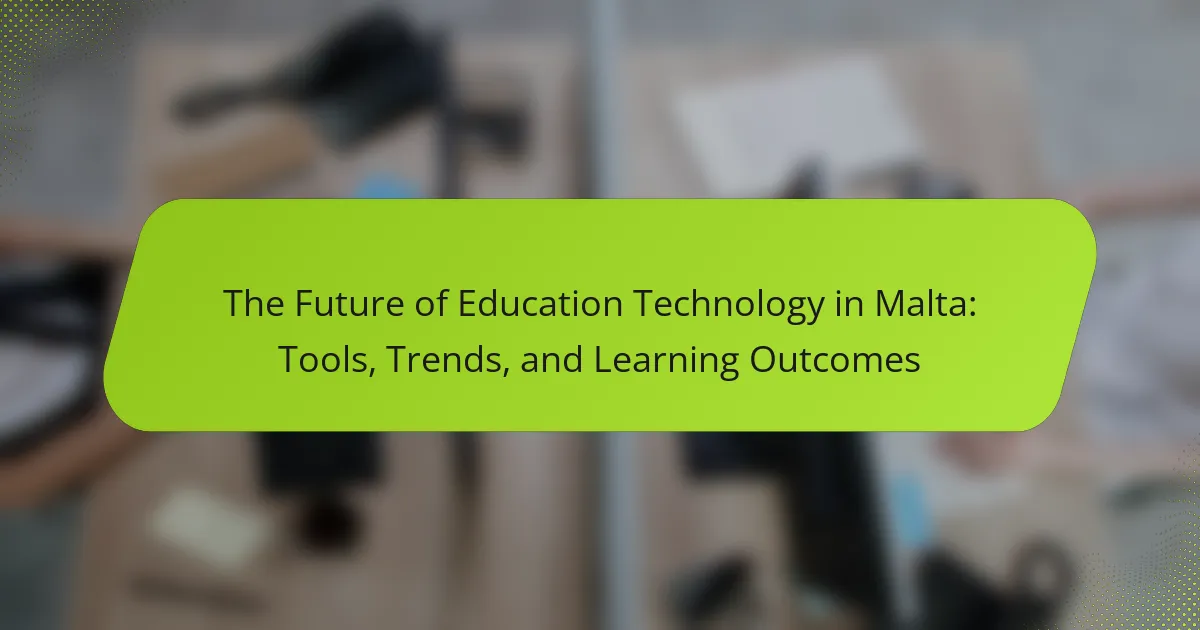
What is the Future of Education Technology in Malta?
The future of education technology in Malta is poised for significant growth and innovation. Increased investment in digital infrastructure is expected to enhance learning experiences. Schools and universities are likely to adopt blended learning models, combining online and in-person instruction. The integration of artificial intelligence and data analytics will personalize education for students. Enhanced collaboration tools will facilitate communication between educators and learners. Government initiatives are promoting the use of e-learning platforms in various subjects. The COVID-19 pandemic has accelerated the adoption of technology in education. As a result, Malta is likely to see a more tech-savvy generation of learners.
How is education technology currently evolving in Malta?
Education technology in Malta is evolving through increased digital integration in classrooms. Schools are adopting interactive tools and platforms for enhanced learning experiences. The government supports this shift with funding for technological resources. Recent initiatives include the introduction of coding and robotics in the curriculum. Teacher training programs are also being enhanced to include digital skills. The aim is to prepare students for a technology-driven job market. Statistics show a rise in student engagement and academic performance linked to these tools. Overall, education technology in Malta is becoming more accessible and effective.
What are the key drivers of change in Malta’s education technology landscape?
Key drivers of change in Malta’s education technology landscape include government initiatives, increased digital literacy, and the demand for personalized learning. The Maltese government has invested in educational reforms that emphasize technology integration. Initiatives such as the Digital Literacy Strategy aim to enhance skills among students and educators. Increased access to devices and the internet has improved digital literacy across various demographics. Furthermore, schools are adopting adaptive learning technologies to meet individual student needs. The COVID-19 pandemic accelerated the shift to online learning, highlighting the necessity for robust educational technologies. These factors collectively foster an evolving educational environment in Malta.
How do cultural and societal factors influence education technology in Malta?
Cultural and societal factors significantly influence education technology in Malta. The Maltese culture values education and promotes lifelong learning. This cultural emphasis drives the adoption of innovative educational tools. Societal attitudes towards technology also shape its integration in classrooms. Parents and educators often encourage the use of digital resources. The government supports educational initiatives that incorporate technology. For instance, Malta’s National Digital Strategy aims to enhance digital skills in schools. This strategy reflects societal support for technology in education. Additionally, local collaborations with tech companies foster resource development. These partnerships create tailored solutions for Maltese learners. Overall, cultural and societal factors create a conducive environment for education technology growth in Malta.
What are the anticipated trends in education technology for Malta?
Anticipated trends in education technology for Malta include increased use of blended learning. Blended learning combines online and face-to-face instruction. This approach allows for greater flexibility and accessibility for students. Another trend is the integration of artificial intelligence in personalized learning. AI can tailor educational experiences to individual student needs. The use of gamification is also expected to rise. Gamification enhances engagement through game-like elements in learning. Furthermore, there is a growing emphasis on mobile learning solutions. Mobile platforms provide learning opportunities anytime and anywhere. Lastly, collaboration tools are likely to become more prevalent. These tools facilitate communication and teamwork among students and educators.
Which technologies are expected to gain traction in Maltese education?
Artificial intelligence and e-learning platforms are expected to gain traction in Maltese education. AI can personalize learning experiences and streamline administrative tasks. E-learning platforms enhance accessibility and flexibility for students. According to a recent report by the Malta Chamber of Commerce, 70% of educators believe AI will transform teaching methods. Additionally, over 60% of students prefer online learning due to its convenience. These technologies are shaping the future of education in Malta.
How will artificial intelligence impact learning experiences in Malta?
Artificial intelligence will enhance learning experiences in Malta by personalizing educational content. AI can analyze students’ learning patterns and adapt resources accordingly. This customization helps address individual strengths and weaknesses. Additionally, AI-powered tools can provide real-time feedback to students. Such immediate responses can improve engagement and retention of information. AI can also automate administrative tasks for educators. This allows teachers to focus more on direct student interaction. Research indicates that personalized learning can significantly boost academic performance. A study from the European Commission highlights the effectiveness of AI in education across Europe, including Malta.

What tools are being utilized in Malta’s educational technology?
Malta’s educational technology utilizes various tools to enhance learning. Key tools include interactive whiteboards, learning management systems, and digital resources. Interactive whiteboards facilitate collaborative learning and engagement in classrooms. Learning management systems, like Moodle, support course management and student tracking. Digital resources encompass educational apps and online platforms that provide access to a wide range of learning materials. Additionally, tools like video conferencing software enable remote learning and communication. These technologies aim to improve educational outcomes and accessibility in Malta’s schools.
What are the most popular education technology tools in Malta?
The most popular education technology tools in Malta include Google Classroom, Microsoft Teams, and Moodle. Google Classroom is widely used for managing coursework and facilitating communication between teachers and students. Microsoft Teams serves as a platform for virtual classrooms and collaborative learning. Moodle is an open-source learning management system that supports course creation and online learning. These tools have been adopted in various educational institutions across Malta, enhancing the learning experience and accessibility for students.
How do these tools enhance teaching and learning processes?
Education technology tools enhance teaching and learning processes by facilitating personalized learning experiences. These tools provide tailored content that meets individual student needs. They enable teachers to track student progress in real-time. This tracking helps identify areas where students struggle. Additionally, technology fosters collaboration among students through interactive platforms. Such platforms encourage peer-to-peer learning and engagement. Research indicates that technology integration can improve student motivation and retention rates. For example, a study by the University of Michigan found that technology use in classrooms increased student participation by 30%. Overall, these tools create a more dynamic and effective learning environment.
What are the unique features of these tools that cater to Maltese educators?
These tools offer unique features tailored to Maltese educators. They include localized content that aligns with the Maltese curriculum. They also provide multilingual support, facilitating communication with diverse student backgrounds. Additionally, these tools incorporate interactive learning modules that engage students effectively. Real-time analytics allow educators to track student progress efficiently. They often feature collaboration tools that promote teamwork among students. Accessibility options ensure that all students can benefit from the technology. Finally, professional development resources are included to help educators enhance their teaching skills.
How are schools in Malta integrating these tools into their curriculum?
Schools in Malta are integrating education technology tools into their curriculum through various methods. They are adopting interactive learning platforms to enhance student engagement. These platforms often include gamified learning experiences and collaborative projects. Teachers receive training on how to effectively use these tools in their lessons. Schools also incorporate digital resources such as e-books and online databases. This integration aims to improve digital literacy among students. Recent initiatives have focused on STEM education, utilizing technology to foster innovation. The Maltese government supports these efforts through funding and policy frameworks.
What strategies are being employed for effective integration?
Effective integration strategies in education technology include personalized learning, collaborative tools, and professional development for educators. Personalized learning tailors educational experiences to individual student needs, improving engagement and outcomes. Collaborative tools enhance communication and teamwork among students and teachers. Professional development equips educators with the skills to effectively use technology in the classroom. Research shows that schools implementing these strategies see improved student performance and satisfaction. The integration of technology in Malta’s education system aims to create a more inclusive and effective learning environment.
What challenges do educators face when adopting these tools?
Educators face several challenges when adopting educational technology tools. One major challenge is the lack of adequate training. Many teachers are not familiar with how to effectively integrate these tools into their teaching practices. This results in underutilization and frustration. Additionally, there is often resistance to change among educators. Some may prefer traditional teaching methods and feel overwhelmed by new technologies. Another challenge is the availability of resources. Schools may lack the necessary funding to purchase and maintain advanced technology tools. Technical issues can also hinder adoption. Educators may encounter software glitches or hardware malfunctions, disrupting the learning process. Finally, there is the challenge of ensuring equitable access for all students. Not all students may have access to the required devices or internet connectivity at home. These challenges collectively impact the effective implementation of educational technology in classrooms.

What learning outcomes are associated with education technology in Malta?
Education technology in Malta enhances student engagement and improves learning outcomes. It facilitates personalized learning experiences tailored to individual needs. This approach fosters critical thinking and problem-solving skills among students. Moreover, education technology promotes collaboration through digital tools and platforms. Increased accessibility to resources is another significant outcome. Students benefit from interactive learning materials that cater to diverse learning styles. Research indicates that technology integration correlates with higher academic achievement in various subjects. The National Commission for Further and Higher Education in Malta supports these findings through ongoing assessments of educational practices.
How does education technology improve student performance in Malta?
Education technology improves student performance in Malta by enhancing engagement and personalized learning experiences. Tools like interactive software and online resources make learning more accessible. Students benefit from immediate feedback through educational apps. This leads to better understanding and retention of material. Statistics show that schools using technology report higher student achievement rates. For instance, a study by the Malta College of Arts, Science, and Technology found a 20% increase in test scores among tech-integrated classrooms. Additionally, technology fosters collaboration among students, promoting teamwork and communication skills. Overall, education technology plays a crucial role in elevating academic outcomes in Malta.
What metrics are used to measure the impact of technology on learning outcomes?
Metrics used to measure the impact of technology on learning outcomes include standardized test scores, student engagement levels, and retention rates. Standardized test scores provide quantitative data on student performance before and after technology integration. Student engagement levels can be assessed through participation rates and time spent on educational platforms. Retention rates indicate how well students retain information over time, reflecting the effectiveness of technology in enhancing learning. Additionally, qualitative measures such as student feedback and teacher observations offer insights into the learning experience. Research has shown that technology can improve learning outcomes when effectively integrated into the curriculum, highlighting its potential benefits.
How do different demographics respond to technology-enhanced learning?
Different demographics respond to technology-enhanced learning in varied ways. Younger students generally adapt quickly to digital tools. They often show higher engagement levels and better performance in online environments. Older adults may face challenges with technology but can benefit from tailored training. Research indicates that age influences comfort and effectiveness in using technology for learning. For instance, a study by Pew Research Center found that 93% of adults aged 18-29 use online learning resources, compared to 54% of those aged 65 and older. Additionally, socioeconomic status impacts access to technology and internet resources. Students from higher-income backgrounds often have more opportunities to engage with technology-enhanced learning. In contrast, those from lower-income demographics may experience barriers, affecting their learning outcomes.
What skills are students developing through the use of education technology?
Students are developing critical skills through the use of education technology. These skills include digital literacy, which enables students to effectively use digital tools. Problem-solving skills are also enhanced as students engage with interactive learning platforms. Collaboration skills improve through group projects facilitated by technology. Communication skills are fostered through online discussions and presentations. Additionally, time management skills are developed as students navigate deadlines and assignments in digital environments. Research skills are strengthened by accessing online resources for information. Creativity is encouraged through multimedia projects and digital content creation. These skills are essential for success in a technology-driven world.
How does education technology prepare students for the future workforce?
Education technology prepares students for the future workforce by equipping them with essential skills. It fosters digital literacy, which is crucial in a technology-driven job market. Students learn to use various software and tools that are commonly used in professional environments. This exposure enhances their adaptability to new technologies. Furthermore, education technology promotes collaborative learning through online platforms. Such collaboration mirrors real-world teamwork scenarios. Additionally, it encourages critical thinking and problem-solving skills through interactive learning experiences. According to a study by the World Economic Forum, 65% of children entering primary school today will work in jobs that do not yet exist. This underscores the importance of integrating technology in education to prepare students for an uncertain future.
What role does critical thinking play in technology-driven learning environments?
Critical thinking is essential in technology-driven learning environments. It enables learners to analyze information critically. This skill helps in evaluating the credibility of online sources. Students can discern biases and misinformation more effectively. Technology often presents vast amounts of data. Critical thinking aids in synthesizing this information into coherent knowledge. Research shows that students who engage in critical thinking perform better academically. According to a study by Facione (2011), critical thinking skills lead to improved problem-solving abilities. Thus, critical thinking enhances learning outcomes in technology-rich educational settings.
What best practices should educators follow when implementing education technology?
Educators should follow several best practices when implementing education technology. First, they must assess the specific needs of their students. This ensures that the technology aligns with learning objectives. Second, educators should provide adequate training for both teachers and students. Research indicates that effective training increases technology adoption rates. Third, they should integrate technology into the curriculum seamlessly. This approach enhances engagement and learning outcomes. Fourth, continuous evaluation of the technology’s effectiveness is crucial. Regular feedback helps in making necessary adjustments. Lastly, collaboration among educators can lead to shared best practices. Studies show that collaborative environments foster innovation and improve teaching methods.
How can educators ensure equitable access to technology for all students?
Educators can ensure equitable access to technology for all students by implementing targeted initiatives. They should assess students’ access to devices and internet connectivity. Providing devices to underprivileged students is essential. Partnering with local businesses can facilitate donations of technology. Schools can also offer internet subsidies for low-income families. Training teachers to integrate technology effectively fosters an inclusive environment. Regularly evaluating technology access helps identify gaps. Research shows that equitable technology access improves learning outcomes. A study by the Pew Research Center found that students with consistent access perform better academically.
What resources are available for professional development in education technology?
Professional development resources in education technology include online courses, workshops, and webinars. Organizations like ISTE offer training programs tailored for educators. Many universities provide certification programs in educational technology. Online platforms like Coursera and edX host courses from leading institutions. Additionally, local educational agencies often organize regional workshops. Networking opportunities through conferences also support professional growth. Research indicates that continuous training improves technology integration in classrooms.
The main entity of the article is education technology in Malta. The article explores the future landscape of education technology in Malta, highlighting key drivers of change, current trends, and the impact of cultural factors. It discusses the evolution of digital tools in classrooms, the integration of artificial intelligence, and the anticipated rise of blended learning models. Additionally, it examines the unique features of popular education technology tools, their role in enhancing teaching and learning processes, and the associated learning outcomes for students. The article also addresses challenges faced by educators in adopting these technologies and emphasizes the importance of equitable access and professional development resources.
